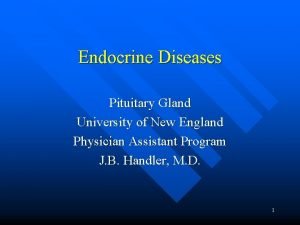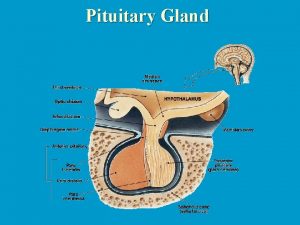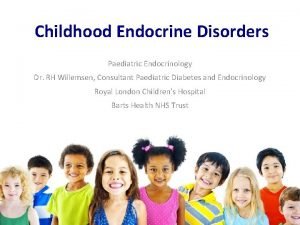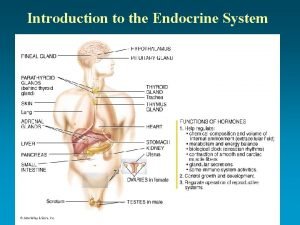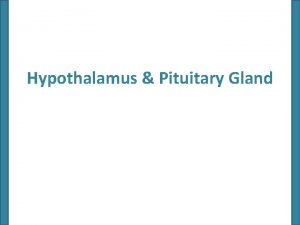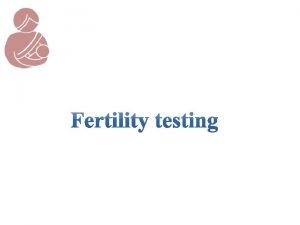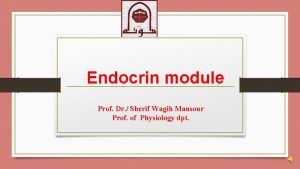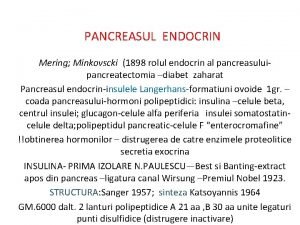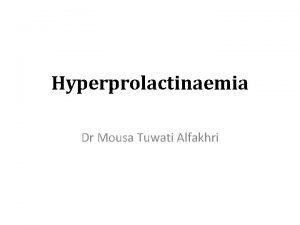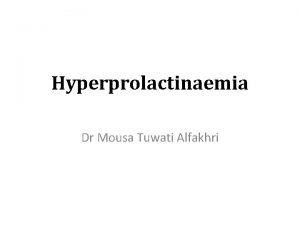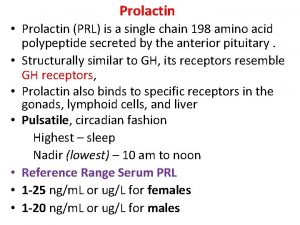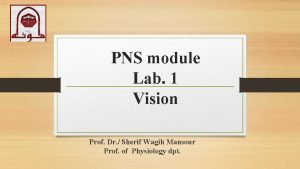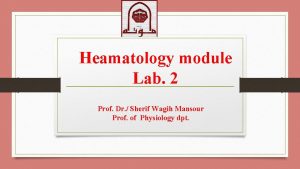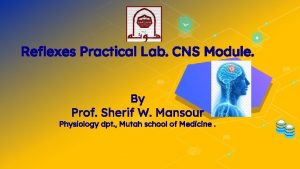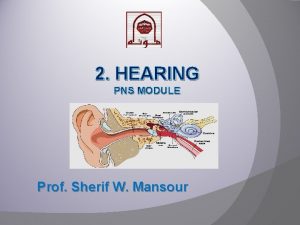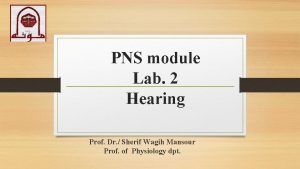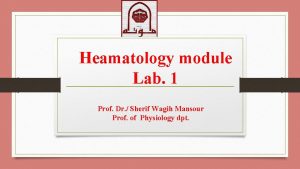2 Endocrin module Prolactin H Prof Dr Sherif














- Slides: 14

2 -Endocrin module Prolactin H. Prof. Dr. / Sherif Wagih Mansour Prof. of Physiology dpt.

Prolactin hormone -It is one of the hormones of the anterior pituitary gland, secreted by the Lactotroph cells (alpha cells). It is a protein consists of 170 amino acids with a molecular weight of 25. 000. -Dopamine is formed in the hypothalamus and stored in the median eminence. It is secreted into the hypothalamo -hypophyseal portal capillaries to tonically inhibit prolactin release from pituitary lactotrophs.

• Control of secretion: 1. Prolactin release is under the control of the hypothalamus, the hypothalamic effect is mainly tonic inhibition. Two hypothalamic neuresecretions have been reported in prolactin regulation : a-The dominant is inhibitory (Prolactin Release Inhibiting Factor-PIF) DOPAMIN. b- A prolactin Releasing Factor (PRF). 2. Thyroxine and Oestrogens affect prolactin secretion as does hypothalamic thyrotropin releasing hormone (TRH). -Thyroxine →inhibition of prolactin secretion via -ve feedback decreases the number of TRH receptor sites on the lactotrophs. -Estrogens → stimulate the release of prolactin via: • a-increase the availability of TRH receptor sites on the lactotrophs • b- stimulate directly the lactotrophs. • c-It also increase the mitotic activity of the lactotrophs.

• Normal Level of Prolactin ; - The normal level of serum prolactin is 10 -25 ng/ml with a marked diurnal variation in which the peak level occurs 4 -5 hours after the onset of sleep. - During Pregnancy, prolactin levels rise to high concentrations reaching a peak of 200 -400 ng/ml at term. The initial rise of serum prolactin with pregnancy occurs at 7 -8 weeks of gestation. It correlates with the increase in estradiol secretion from the placenta which appear to act at the hypothalamic and pituitary levels to increase prolactin secretion.

- In a non-breast-feeding woman , prolactin level returns to normal non pregnant level in 7 days after delivery. However , in breastfeeding women prolactin levels decline approximately 50% (to about 100 ng/ml) in the first postpartum week. - Until 2 -5 months postpartum , suckling increases the prolactin level from a baseline of about 40 -50 ng/ml to 400 -800 ng/ml (about 10 -20 fold increase after suckling).

Functions of prolactin 1 -Prolactin may be involved in the regulation of gonadal function in the females. 2 -No clear function for prolactin has been established in males. 3 - It has a general metabolic functions similar to those of Somatotrophin (growth hormone) i. e. diabetogenic. 4 - It is the principal hormone involved in milk formation (formation of Casein). 5 - During pregnancy , the high level of prolactin stimulates significant breast growth , however , no lactation occurs, only colosatrum is produced (composed of desquamated epithelial cells and transudate). Lactation is inhibited during pregnancy by progesterone which interferes with prolactin action at the receptor sites in the alveolar cells. The rapid disappearance of oestrogen and progesterone from the maternal circulation after delivery is the trigger for initiation of milk production.

Disorders of Anterior pituitary Function A. Hypopituitarism (underactivity) • 1 -Dwarfism: A condition due to deficiency of growth hormone during childhood. In the Lorain type of dwarfism the features of the body develop in appropriate proportion to each other , but the rate of development is decreased. The child on reaching the age of 20 may have the bodily development of a child of 10. - No thyroid or adrenocortical deficiency. - No mental retardation (Wise person with small stature). - Hypogonadism. - In the Lorain type of dwarfism there ia a hereditary inability to form Somatomedin-C in response to growth hormone secretion , it is known as Growth Hormone Insensitivity Syndrome. • 2 - Frohlich’s syndrome (Dystrophia Adiposo-Genitalis) : -It is a condition due to damage of the pituitary and hypothalamus by a tumor. - It is characterized by : - Stunted and stupid person. - Obesity. insipidus (polyuria). - Infantilism. - Diabetes - Disturbance of temperature and sleep mechanisms (spends much of their times asleep) Increased appetite. -

• 3 - Simmond’s disease (Pituitary Cachexia): - This condition is a panhypopituitarism (generalized hypofunction of adenohypophysis), most commonly follows severe postpartum hemorrhage which somehow leads to extensive pituitary necrosis (Sheehan's Syndrome) → depression of trophic hormones of thyroid , adrenal and gonads , and loss of the direct pituitary influence on many organs. • Clinical picture : -Premature senility (Progeria), loss of hair, shrunken skin and emaciation (loss of body weight). - Asthenia (muscular weakness and easy fatigue). - Mental deterioration. - Atrophy of the thyroid gland with signs of myxoedema , low B. M. R. (below-20) , increased serum cholesterol. - Atrophy of adrenal cortex. - Increased sensitivity to insulin and hypoglycemia. - Before puberty → infantilism. sterility. - After puberty → hypogonadism , impotance and - Polyuria (mild). - Anaemia.

B. Hyperpituitarism (Overactivity) • 1 -Gigantism : It is a hyperpituitarism with excessive formation of growth hormone by the Acidophil (alpha) cells before the union of the epiphysis of the long bones. • Clinical picture : -All body tissues grow rapidly i. e. general overgrowth of the skeleton so that the person becomes a Giant. -High B. M. R. (direct effect of growth hormone on the metabolic activity + effect of thyrotropin). • Hyperglycaemia → lowered general resistance. • Low gonadotropins → hypogonadism. • Short life , if survives till adulthood → Acromegaly

• 2 -Acromegally : (Akros = extremily ; megaly = large): • It is a hyperpituitarism with excessive formation of growth hormone by the acidophils after the union of the piphysis (during adult life). • Clinical picture : • Coarsening of facial features due to increase of connective tissue. • Increased cartilaginous growth results in an enlargement of ears and nose. Overgrowth of certain parts of the skeleton in width only (thickening). Protruding lower jaw , upper jaw, lower half of the face , supraorbital ridge , and separation of teeth (bone deformities ). *The hands and feets are enlarged (thick, broad fingers) the big hands may reach a level below knees. -Bowing of the spine (kyphosis). -Overgrowth of soft tissues; lips, tongue , splenomegaly and hepatomegaly. -Hyperthyroidism, increased B. M. R. , hyperglycaemia and glycosuria. • Hypogonadism (preceded by temporary increase in sexual function).

3. Cushing’s Syndrome ( Nelson’s Syndrome) : Adenoma of anterior pituitary formed of basophil (Beta) cells leading to increased secretion of ACTH (Corticotropin) 4. Hyperprolactenaemia: Excessive production of prolactin hormone from the anterior pituitary as a result of removal of the inhibitory influence of the hypothalamus or excessive stimulation of pituitary lactotrophs. • Causes of hyperprolactinaemia: 1. Hypothalamic Dopamine Deficiency : Stress can inhibit hypothalamic PIF (Dopamine): e. g. trauma, surgical procedures and anaesthesia. 2. Defective Transport Mechanisms. 3. Lactotroph insensitivity to Dopamine. The use of dopamine receptor blocking agents as Phenothiazines. 4. Stimulation of Lactotrophs: Hypothyroidism- Excessive estrogen administration

• Clinical manifestations : 1. Effect of the Structural lesion (Pituitary Tumor): Headache, visual field defects , external ophthalmoplegia, associated dysfunction of secretion of other anterior pituitary hormones , and impotence in males 2. Direct Effect of Excess Prolactin : • a- Galactorrhoea in 50 % of patients with high prolactin levels more than 100 ng/ml (normal level below 20 ng/ml). • b- Changes in the breast: . Well developed breast , the Montgomery tubercles are hyperplastic. . Galactorrhea is usually found in 30 -80 % of women and 30% only in men because androgens reduce prolactin binding at the lactogenic receptors in the alveolar cells. . No Gynaecomastia (enlargement of the breast) in male patients with hyperprolactinaemia but

• c- Hypogonadism and menstrual abnormalities ; amenorrhoea oligomenorrhoea , regular cycles with infertility or menorrhagia in females and impotence in males. -Suppression of gonadal function in hyperprolactinaemia may be due to : 1 - Suppression of pituitary gonadotrophin secretion. 2 -Inhibition of the positive Estrogen feedback on LH secretion in women. 3 - Increase in adrenal androgen secretion → hirsutism. 4 -Blockade of the effects of gonadotrophins at the gonadal level ; prolactin interfere with LH and FSH action at the gonads, blocking progesterone synthesis. The important mechanism is that prolactin feedback at the hypothalamus, which alters secretion of Gn. RH causing LH and FSH secretion at a low level inappropriate to gonadal steroid level. Abnormalities in LH pulsatility also occur.

Thank You

